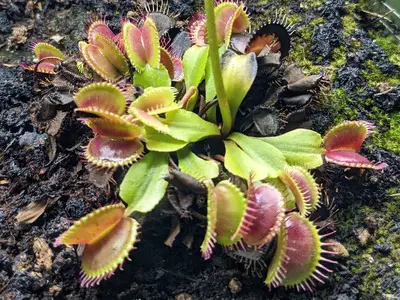Caring for Venus fly trap has some added difficulty beyond most easy houseplants, however I would consider it a moderate difficulty level (you will see why below). I have grown Venus fly traps for 5 plus years and will share key information so anyone can grow Venus fly traps at home with success.
Key difficulties when growing flytraps:
- Venus fly trap require carnivorous plant soil, distilled water, and pots that do not leach minerals to the ground
- To thrive Venus fly traps need full sun for 6+ hours a day
- Their soil must be kept humid at all times (never dry)
- They require a dormancy period in the winter month if you would like to have them live for many years. Follow this link to learn more about the dormant period.. Follow this link to learn more about the dormant period.
Easy aspects from Venus fly trap care:
- Overwatering is very difficult which is great for people that tend to water too much
- Venus fly traps adapt to different temperatures (very hot summers, freezing temperatures, etc) and humidity levels
- Venus fly traps won’t suffer with too much light, they always like extremely bright environments
How to grow Venus fly trap quickly
- Repot once every year at the end of dormancy
- Ensure your plant goes dormant every year
- Remove flower buds before they bloom
- Provide as many direct sunlight hours as possible (10+)
- Feed once a month
Difficulty Level: Moderate
Venus fly traps are native to North Caroline and South Caroline in the United States. In their natural habitat they grow in very sunny and humid climates year round.
These plants grow in coastal plain ecosystems that lack nutrients in the ground and the water. For that reason is that Venus fly traps developed their carnivorous bug trapping mechanisms. They consume bugs to supplement their diet and obtain extra nutrition.
Because of the very unique environment where they live in the wild, Venus fly traps require special water, soil, and even pots. But, don’t worry it is easy to find all these elements.
If you are currently struggling with a plant, this article can help you: How to Save Your Venus Fly Trap.
Venus Fly Trap Care
Each of these sections will help you tackle key aspects when growing a Venus Fly trap.
Soil
Always employ nutrient-free mineral-free carnivorous plant soil for your Venus fly trap. Using standard potting soil like Miracle Grow, succulent soil, or garden soil will kill your plant very quickly!
Some good options for carnivorous plant soil are a mix of moss with a draining agent—for example, sphagnum moss or peat moss and silica sand or perlite as draining agents.
Several vendors offer carnivorous plant soil mixes. I personally buy this blend from amazon.
You can also make your own carnivorous plant soil. Here is a guide to make your own soil.
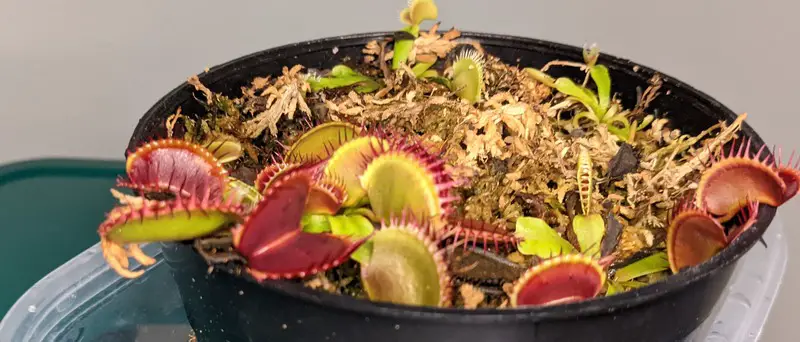
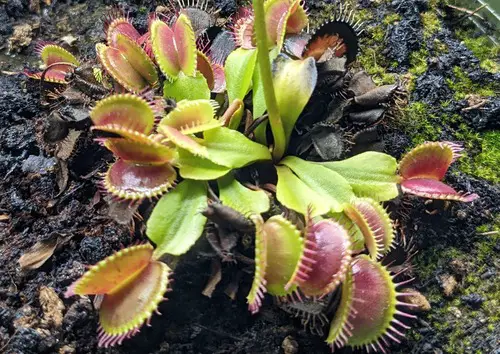
Water
Tap water or bottled water contains too many minerals and nutrients to be suitable for Venus flytraps. These plants require nutrient-free mineral-free water. You can employ any source of pure water, such as:
- Rainwater
- Distilled water
- Reverse osmosis water
From these three options I usually buy distilled water as rain is not available in my area very often and reverse osmosis systems are expensive. You can buy pure distilled water jugs in most grocery stores.
Make sure the water is completely pure. Some companies sell distilled water that is enhanced with minerals, electrolytic, or elements for flavor. Such water is unsuitable for carnivorous plants due to the added components.
Venus flytraps thrive in humid environments.
The soil Venus flytraps should always remain moist; it should never be completely dry.
Water the soil from the top or passively from the bottom until the soil is moist throughout.
The best way to water Venus fly trap is using the tray method. Place the plant pot in a tray with water (1-2 inches in depth). Let the plant absorb the water and refill the tray once it is dry.
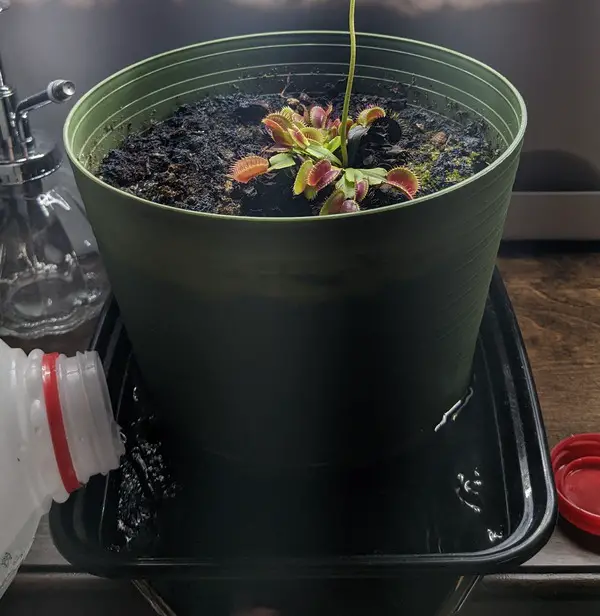
Venus fly traps are not native to swamps, so they don’t need to be in Waterloo conditions. However, they love humid soil and suffer greatly when the soil is completely dry.
When selecting the soil, make you find the correct type. Here is a guide that lists the best soil options.
Lighting
Venus flytraps require plenty of sunlight to be healthy.
Venus flytraps should receive 12 hours of direct sunlight to grow it their full potential. But, they can live a healthy life with a minimum recommended amount is 6 hours of direct/indirect sunlight.
Growers can employ natural light, or they can supplement lighting by using a plant light.
Sunlight works best for Venus fly trap as it is the most powerful source. If natural light is not an option for you can check out this guide on artificial light growing.
These are the grow lights I use to grow Venus flytraps, sundews, and pitcher plants indoors:
- Small plant light for 1-4 plants: https://amzn.to/3TInhXR
- T8 LED light fixture for multiple plants (6500k Cool White): https://amzn.to/3uWoeh2
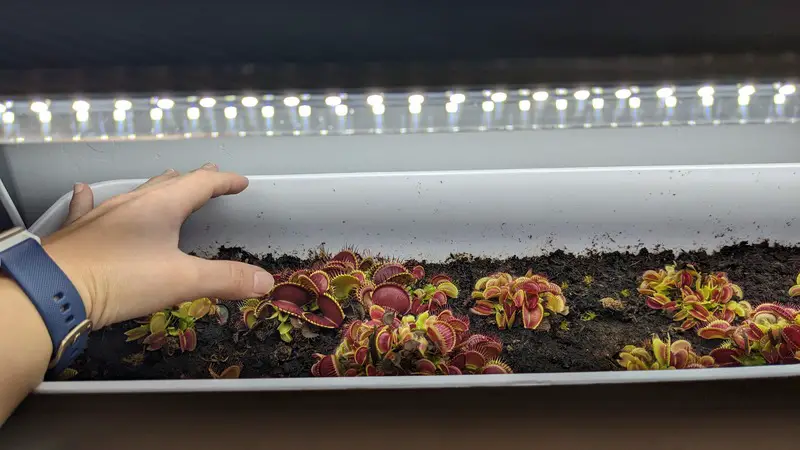
Pots
Venus flytrap can grow in a wide variety of pot materials.
The best materials are plastic, Styrofoam, and glazed ceramic. These three options provide insulation and they do not leak any compounds to the soil within the pot.
Avoid any unglazed clay pots or terracotta pots. Both materials, leak minerals to the soil. Any time of additional minerals or nutrients in the ground it is harmful to Venus flytraps.
Here is a guide to pot dimensions for a mature fly trap (seedlings can grow in much smaller containers)
- Pot diameter: 4 to 5 inches (10.5cm – 12.7 cm)
- Pot depth: 6 inches (15.24 cm)
These pots are great for Venus flytraps: https://amzn.to/3IYVGKU. Larger pots promote root growth and propagation 🙂
If you need more information in the pot size, dimension or if you can reuse an existing container you own: here is the pot guide for fly traps.
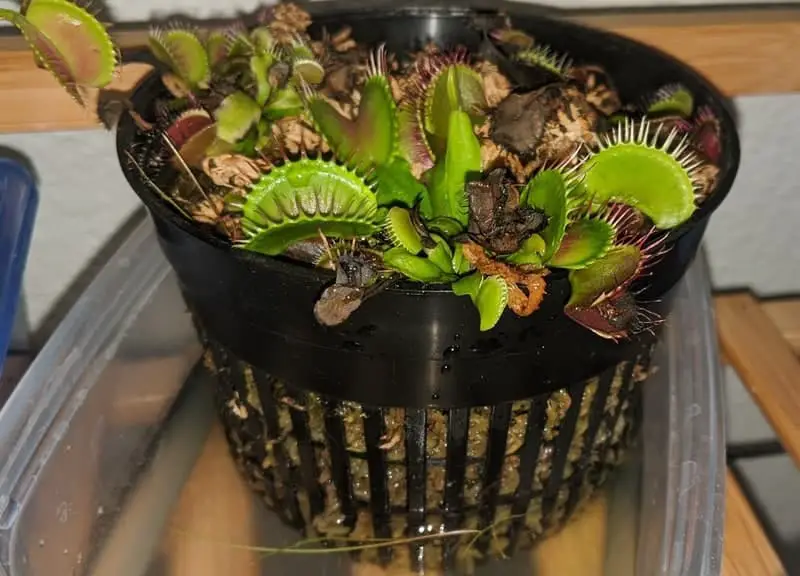
Feeding
Venus flytraps do not need eat bugs to survive, but consuming them offers key nutrients and promotes growth.
Most Venus fly traps growing outdoors can capture their own bugs and do not require feeding.
Indoors flytraps might benefit from feeding every now and then.
You can employ insects, spiders, diluted maxsea fertilizer, fish food or freeze dried insects to feed your plant.
Never employ human food. That food will rot and produce odor/attract pests.
This article has a complete list of what you should and shouldn’t feed a Venus fly trap. It can help you as a guide.
The easiest way to feed a Venus fly trap is to use a single bug that is at most 1/3 of the size of the trap you intent to feed.
Place the live bug inside the trap making sure it touches some of the filaments inside the leaf (each blade has 3 thin filaments)
The trap will close when something touches the filaments twice in a row. Once the trap is closed, the plant will start digesting the insect.
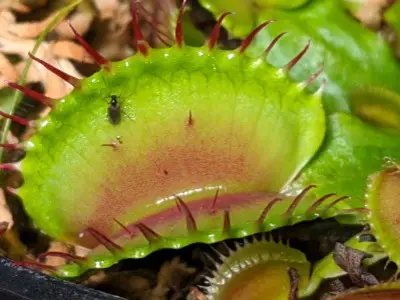
If you are interested in feeding, this article outlines the process step by step with photos and a video.
Besides feeding your plant, you can do more to encourage fast growth. Here are the tips to grow big venus fly traps.
Feeding a single bug once every 2-6 week is a good recommended practice.
Avoid feeding during dormancy and right after repotting.
Dormancy
In their natural habitat, Venus flytraps experience dormancy every year. Dormancy is a hibernation/resting period.
Venus flytraps undergo dormancy when they are exposed to temperatures below 45 F for several weeks.
When they are dormant Venus fly traps shrink is size and lose some leaves
The Venus flytrap dormancy period lasts 3-4 months.
After dormancy the plant regrows stronger than ever and Strats producing flowers and propagating in the spring.
Dormancy is essential for the plant’s development. Venus flytraps can survive without dormancy, but their life expectancy lowers significantly, they only live 2 – 4 years. This is much less than 20 which is their life expectancy.
Since the dormancy process is essential for Venus flytraps, owners must ensure their plant undergoes dormancy once a year.
How to Grow Venus fly Trap Faster
These are some tips to speed the growth from your Venus fly trap.
Repot once every year at the end of dormancy: Repotting with fresh soil helps promote growth and root health
Ensure your plant goes dormant every year: Dormancy is required for the survival of the plant plus it promotes growth during the growing season (spring/summer)
Remove flower buds before they bloom: The flowering process takes significant energy from the plant. Remove the stalks as soon as you see them to maximize growth. In this article you can learn more about the flowering process and what to do.
Provide as many direct sunlight hours as possible (10+): More lighting does promote growth speed.
Feed once a month: Ensure your plant has access to bugs or feed once a month for a nutrient boost.


